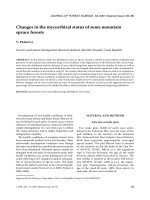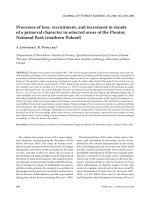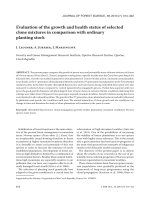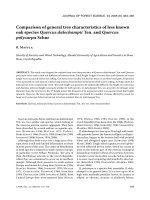Báo cáo lâm nghiệp: "Comparison of the impact of blue spruce and reed Calamagrostis villosa on forest soil chemical properties" pot
Bạn đang xem bản rút gọn của tài liệu. Xem và tải ngay bản đầy đủ của tài liệu tại đây (208.8 KB, 7 trang )
208 J. FOR. SCI., 55, 2009 (5): 208–214
JOURNAL OF FOREST SCIENCE, 55, 2009 (5): 208–214
Nutrient content as well as other chemical and
physical properties of soils are the consequence of
bedrock, abiotic soil forming factors and impact of
organisms – plants and animals. e inner ecosys-
tem nutrient exchange has following sub-processes:
production, conversion, mineralization, recycling
(O 1994). Plants use nutrients included in at-
mosphere and soil liquids to build phytobiomass.
One part of the biomass is through litterfall directly
transported to soil and transformed by bio-chemical
processes. Direct impact of specific plant species on
soil characteristics differs (S, M 2005).
Character of litterfall influences upper soil organic
(humus) horizons primarily.
After the air pollution induced decay of forest
stands in the mountain regions of the Czech Re-
public in 1970s to 1990s, there was a problem of
autochthonous tree species planting failure on the
climatically extreme localities. Norway spruce and
European beech were main autochthonous species
there. e problem was temporarily solved by al-
lochthonous – introduced tree species plantings
(Š 1982).
Blue spruce (Picea pungens Engelm., B. s.) of
North America was the most extended substitute
tree species used in the higher mountain localities
of the Czech Republic (M et al. 2005). It was
used as a substitute tree species in former Eastern
Germany too (R 1982). Until now, air pollution
load decreased and blue spruce forest stands are be-
ing converted with the autochthonous tree species
(mostly Norway spruce, but also European beech etc.
– B, K 2008).
Production potential of blue spruce is lower than
of Norway spruce (Š 1976; N, S
2004), negative impact of blue spruce on the forest
soils is mentioned in the literature (K 1989;
P 1997; R et al. 2002; P et
Supported by the Ministry of Agriculture of the Czech Republic, Research Project No. MZE 0002070203.
Comparison of the impact of blue spruce and reed
Calamagrostis villosa on forest soil chemical properties
O. Š, D. D
Forestry and Game Management Research Institute, Strnady, Opočno Research Station,
Opočno, Czech Republic
ABSTRACT: e impact of blue spruce (Picea pungens) and reed (Calamagrostis villosa) cover on quantity and quality
of upper soil layers was investigated. e research was conducted in the Jizerské hory Mts., Czech Republic (altitude
880 m, acidic spruce forest site type – 8K). Mean weight of dry matter of holorganic horizons was similar under both
variants. Totally, there were accumulated 153 t/ha of dry matter of humus horizons in blue spruce and 174 t/ha in reed.
Soil pH (KCl) varied from 3.7 to 3.2 under blue spruce stand and from 3.6 to 3.3 under reed. e differences of concen-
trations of nutrients (P, K, Ca, Mg) were not found significant either. Only L horizon showed significant differences:
there were higher values of cation exchangeable capacity (T) and higher content of exchangeable bases (S) under reed.
We found very similar forest-floor humus properties under both species. erefore we can not state worsening of the
soil conditions under blue spruce compared to areas covered with tested forest weed species.
Keywords: Picea pungens; forest weed; Calamagrostis villosa; upper soil layers quality and quantity; Jizerské hory Mts.
J. FOR. SCI., 55, 2009 (5): 208–214 209
al. 2005): neither it covers the soil surface enough nor
protects soil from desiccation and worse chemical
properties. Blue spruce has similarly unfavourable
litterfall like Norway spruce, but in lower amounts,
which leads to further soil degradation comparable
with the long-term clear-cuts (R et al. 2002).
On the contrary, positive effect of young blue spruce
stand shelter to interplantings of beech in higher
mountain locations (more than 850 m a.s.l.) is men-
tioned (B, K 2008).
Clear-cut reed Calamagrostis villosa (Chaix) J.
F. Gmelin is the most common expansive clear-cut
grass species in the central European mountains. Its
expansion can help prevent high losses of nutrients,
which take place after disturbance of the forest
environment (G et al. 1979), but it is also
described as the most problematic species for natural
as well as artificial regeneration (J 1998; Š
et al. 2000; K et al. 2000). Positive effect of
Calamagrostis grass cover (C. villosa and C. arundi-
nacea) on the soil environment described F et al.
(2005). In their study, both species act as a nitrogen
sink since they take up and immobilize this element
in plant biomass and undecomposed litter. Conse-
quently, the swards of grasses were demonstrated
to mitigate the acidification of soil solution and the
leaching of basic cations of Ca and Mg from soil.
is study aims to compare impact of 20 year last-
ing cover of blue spruce, and clear-cut reed Calama-
grostis villosa on the former Norway spruce clear-cut
to the upper soil layers quality and quantity.
MATERIALS AND METHODS
Our research was done on the locality of Plochý
in the upper part of the Jizerské hory Mts., Czech
Republic, altitude 880 m, NW slope to 5°, acidic
spruce forest site type (8K). In this locality, blue
spruce forest stand was planted from 1985 to 1990
(repair planting), after the forest decay of Norway
spruce forest stand caused by air pollution disaster.
Due to the planting failure, strips of the locality
were for the whole period deforested and covered by
clear-cut reed Calamagrostis villosa. In 2006, mean
height of the blue spruce stand was 4.4 m, density
was 2,340 trees/ha (
Š 2007). Its stand canopy
is closing, with very rare occurrence of forest weed.
In autumn 2006, transects of seven soil pits in a
regular distance of 3 m in blue spruce (variant PP)
and grass Calamagrostis villosa (CV) were settled.
Horizons of L/Weed, F, H and Ah (layer of the min-
eral matter with high content of humus) were taken
on every pit in an iron frame 25 × 25 cm. e pa-
rameters analyzed were: total dry weight, active and
exchangeable acidity, nutrient contents by Mehlich
III. (P, K, Ca, Mg – M 1984), characteristics
of adsorption complex (by Kappen: S – content of
exchangeable bases, T – cation exchangeable capac-
ity, H – hydrolytical acidity and V – saturation of
the adsorption complex with bases, K 1929),
oxidable C (Springer-Klee method) and total N
(Kjeldahl method) content and exchangeable titra-
tion acidity.
Mean values and variances were computed by the
Horn’s quantile based method (M, M
1998). Multilevel hierarchicaly designed ANOVA
with Tukey test for multiple comparisons were used
to assess the differences between variants. In some
cases the data were transformed by logarithmic
transformation.
RESULTS AND DISCUSSION
ere was significantly higher thickness of litter
(horizon L) and Ah horizon under Picea pungens
and of humification horizon (H) under Calama-
grostis. e thickness of all humus layers together
was significantly higher in CV (Table 1). Process of
the holorganic layer accumulation and formation
may last many decades, even centuries (S,
M 2005), so advance changes of its character
are expected.
Table 1. ickness of soil horizons (cm). Heterogeneous groups are designated by letters of the alphabet
Horizon
Picea pungens Calamagrostis villosa
mean st. dev. mean st. dev.
L 2.86a 0.69 1.93b 0.32
F 2.86 0.83 3.21 0.51
H 3.93a 1.18 6.50b 0.23
Ah 7.29a 1.13 3.79b 1.46
Humus layers total 9.64a 1.78 11.64b 0.47
210 J. FOR. SCI., 55, 2009 (5): 208–214
Mean weight of dry matter of litter/weed horizon
was very similar – almost 48 g per soil pit. Soil un-
der Calamagrostis showed higher accumulation of
dry matter in F and H horizon, but not significantly
(Table 4). Totally there were accumulated 153 t/ha
of dry matter of humus horizons in PP variant and
174 t/ha in CV variant (Table 4). In our study, we
found almost two times more dry matter of humus
layers in PP comparing to outcomes of P
et al. (2005), who studied forest stand of similar age
in similar altitude in the Krušné hory (Ore) Mts.,
but on wet nutrient medium spruce forest site type.
e question is also density of studied forest stand
which was not included in the paper. Dry matter of
humus layers in Norway spruce mature forest stands
of mountain altitudes range according to M
(2002) from 70 to 120 t/ha. Higher accumulation of
humus in our study can be consequence of species as
well as of stand density in the case of blue spruce.
Both soils were very strong acid (K 1998), soil
pH lowers with increasing soil depth (Table 2, Fig. 1).
PP soils had higher variability of acidity (Fig. 1). Even
more acid soils under blue spruce (3.11 pH/KCl in H
horizon) found K (1989) in his study of soil
properties near large air pollution source (in 1980s).
Air pollution is an important factor increasing soil
acidification; K et al. (2006) described forest
soil acidification processes driven by air pollution.
e end of hard air pollution income brought slight
decrease of acidity (B et al. 2005). Soil acid-
ity of Norway spruce forest soils in the Jizerské hory
Mts. described by M et al. (2006) ranged
from 2.85 to 3.55 pH/KCl. On similar forest sites
found D et al. (2007) soil acidity of organic
horizons ranging from 3.2 to 3.4 pH/KCl. Soils with
grass cover (C. villosa) had slightly higher pH values
comparing to adjacent Norway spruce forest stands.
Soil acidity in our study was slightly higher compar-
ing to studies cited above, without real difference
between variants.
ere was significantly higher content of exchange-
able bases in CV litter (15.6 and 9.6 mval/kg). No dif-
ferences in this parameter were found in the rest of
horizons (Table 2). Soils show low saturation of the
adsorption complex with bases (S, M
2004), also with no significant differences. Similar
Table 2. Mean values of the selected pedochemical characteristics. Heterogeneous groups are designated by letters of
the alphabet
Variant Horizon pH/KCl
S
(mval/kg)
T
(mval/kg)
V
(%)
Exchangeable
acidity
(mval/kg)
Exchangeable
H
(mval/kg)
Exchangeable
Al
3+
(mval/kg)
Picea pungens
L
P
L
3.7 9.6a 37.3a 27.6 36.4 9.5 23.5
R
L
0.4 7.2 13.7 11.4 13.2 8.4 26.4
F
P
L
3.3 19.8 70.3 27.3 87.2 9.7 80.7
R
L
0.4 7.7 5.9 10.9 57.3 5.6 58.2
H
P
L
3.4 12.4 60.1 20.1 125.2 3.8 121.6
R
L
0.1 1.4 13.9 2.5 26.7 0.6 26.9
Ah
P
L
3.2 8.0 37.6 21.7 102.3 3.0 99.0
R
L
0.2 3.1 12.1 6.9 17.1 0.5 17.5
Calamagrostis
villosa
L
P
L
3.6 15.6b 49.6b 33.2 49.1 14.1 35.8
R
L
0.2 8.4 9.4 19.3 6.3 7.7 13.1
F
P
L
3.5 17.8 67.9 27.2 89.1 9.0 80.0
R
L
0.1 2.3 8.0 2.3 11.2 1.3 12.9
H
P
L
3.4 13.3 59.2 22.4 114.1 5.1 109.4
R
L
0.1 4.7 7.6 5.5 15.2 1.0 15.4
Ah
P
L
3.3 7.1 33.6 21.1 90.8 2.9 87.8
R
L
0.1 1.1 5.1 0.6 11.4 0.5 10.1
P
L
– mean value computed by Horn’s method, R
L
– pivot range computed by Horn’s method, S – base content, T – cation
exchangeable capacity, V – saturation of the adsorption complex with bases
J. FOR. SCI., 55, 2009 (5): 208–214 211
saturation with bases under 20-year-old blue spruce
forest stand (28.2%) presented K (1989).
There was higher content of exchangeable hy-
drogen cations in CV litter (14.1 and 9.5 mval/kg),
values in other horizons were comparable. Mean
content of exchangeable aluminum (Al
3+
) optically
differed in all horizons, but the differences were not
significant.
There were found no significant differences in
nutrient contents with the exception of phospho-
rus in Ah horizon. ere was significantly more
phosphorus in Ah of PP soil. With the exception of
magnesium, the content of nutrients rapidly lowered
with increasing depth of soil (Table 3).
Also share of carbon and nitrogen was very similar in
both soil variants. K (1989) found significantly
lower content of oxidable carbon under PP (only 14.9%
in humification horizon). His study was conducted in
a lower altitude and all ten tested species had very low
content of carbon in H horizon, so blue spruce was not
an exception. Carbon share of soil under blue spruce
in study of P et al. (2005) corresponds with
our outcomes (34.6% in Grass horizon, 32.0% in L +
F1, 25.6% in F2 + H and 13.0% in Ah).
Fig. 1. Box plots of soil acidity (pH/KCl)
by horizons. PP – soil pits under Picea
pungens, CV – soil pits under Cala-
magrostis villosa
Table 3. Mean nutrient content of soil horizons. Statistically heterogeneous groups are designated by letters of the
alphabet
Variant Horizon
P K Ca Mg Oxidable C Total N
(mg/kg) (%)
Picea pungens
L
P
L
59.0 950.0 1,079.0 250.0 35.4 1.5
R
L
66.0 1,140.0 350.0 208.0 3.0 0.4
F
P
L
38.0 625.0 1,167.0 356.0 33.3 1.7
R
L
16.0 218.0 566.0 204.0 3.0 0.3
H
P
L
17.0 367.0 797.0 234.0 26.7 1.4
R
L
10.0 178.0 122.0 132.0 5.4 0.5
Ah
P
L
6.0a 193.0 411.5 103.0 18.7 0.9
R
L
6.0 132.0 107.0 64.0 6.2 0.2
Calamagrostis
villosa
L
P
L
63.0 1,155.0 1,027.0 317.0 33.0 1.6
R
L
18.0 394.0 358.0 194.0 14.2 0.3
F
P
L
36.0 682.0 996.0 341.0 33.8 1.7
R
L
8.0 276.0 232.0 122.0 2.6 0.2
H
P
L
14.0 375.0 813.0 192.0 27.8 1.6
R
L
4.0 70.0 202.0 16.0 6.5 0.3
Ah
P
L
3.0b 158.5 468.5 105.0 16.8 0.8
R
L
2.0 43.0 41.0 16.0 4.6 0.2
Horizon × variant
L × PP L × CV F × PP F × CV H × PP H × CV Ah × PP Ah × CV
4.1
4.0
3.9
3.8
3.7
3.6
3.5
3.4
3.3
3.2
3.1
3.0
212 J. FOR. SCI., 55, 2009 (5): 208–214
Comparing total amount of nutrients in humus
per ha we found no significant differences. In CV,
average (Horn’s mean) content of potassium was
20% higher (87 and 71 kg/ha) and average content of
calcium was 9% higher (152 and 140 kg/ha). Contents
per ha of other nutrients differed up to few percent.
Total content of oxidable carbon was 16% higher by
CV variant (52 and 44 t/ha) as well. S and
N (2008) in blue spruce stand of very similar
site (800 m a.s.l., acid category, S slope) in the Krušné
hory Mts. found only 82 t of dry matter in humus
horizons. Due to different method of chemical
analysis used in their study (citric acid solution), the
differences of nutrient contents are not objectively
comparable. Under 25-year-old PP stand in lower
altitude P (1995) found only 47.4 t of dry
matter in humus horizons per ha. Actual quantity as
well as quality of upper soil layers seems to be hardly
limited by site conditions.
Despite of conclusions presented in the literature
about the positive effect of Calamagrostis and nega-
tive effect of Picea pungens to the forest soil, we found
very similar pedochemical characteristics of the
holorganical horizons under both species. erefore
we can not state worsening of the soil conditions un-
der blue spruce comparing to areas covered by tested
forest weed species. However, we can expect positive
microclimatic effect of the spruce for interplantings
of selected target species. We can not also ignore
complicated conditions on the sites with Calama-
grostis for natural as well as artificial regeneration.
CONCLUSION
Comparing properties of the soil under blue spruce
and Calamagrostis presented in this study resulted
in detection of very little differences between upper
horizons and the differences were in most cases not
significant. Dry matter of the humus horizons was
slightly higher under Calamagrostis. Only L horizon
showed noticeable differences: there were higher
values of cation exchangeable capacity (T), higher
content of exchangeable bases (S) – significantly,
as well as of exchangeable acidity (without signifi-
cance) under Calamagrostis. From the point of view
of holorganical horizons quality, both stands make
almost identical conditions. Retrospectively, plant-
ing of blue spruce as a substitute tree species proves
effective only considering other awaited effects of its
forest stands, such as positive microclimate effect for
plantings of selected target species.
Further research will be focused on differences in
forest soil under other commonly used tree species
after air pollution damage to forest stands in moun-
tain regions of the Czech Republic.
Reference s
BALCAR V., KACÁLEK D., 2008. European beech planted
into spruce stands exposed to climatic stresses in mountain
areas. Austrian Journal of Forest Science, 125: 27–38.
BORŮVKA L., PODRÁZSKÝ V., MLÁDKOVÁ L., KUNEŠ
I., DRÁBEK O., 2005. Some approaches to the research of
forest soils affected by acidification in the Czech Republic.
Soil Science and Plant Nutrition, 51: 745–749.
DRÁBEK O., BORŮVKA L., PAVLŮ L., NIKODÉM A.,
PÍRKOVÁ I., VACEK O., 2007. Grass cover on forest clear-
cut areas ameliorates some soil chemical properties. Journal
of Inorganic Biochemistry, 101: 1224–1233.
FIALA K., TŮMA I. et al., 2005. e role of Calamagrostis
communities in preventing soil acidification and base cation
losses in a deforested mountain area affected by acid deposi
-
tion. Plant and Soil, 268: 35–49.
Table 4. Mean content of dry matter, nutrients and humus in humus layers per ha computed by Horn’s mean
Variant/ha Horizon
Dry
matter
(t)
P K Ca Mg Oxidable C Total N Humus
(kg) (t)
Picea pungens
L 7.62 0.45 7.24 8.22 1.90 2.70 0.11 4.58
F 42.50 1.61 26.56 49.59 15.13 14.15 0.72 24.06
H 103.12 1.75 37.85 82.19 24.13 27.53 1.44 46.81
Total 153.23 3.82 71.64 140.00 41.16 44.38 2.28 75.45
Calamagrostis
villosa
L 7.74 0.49 8.94 7.95 2.45 2.56 0.12 4.34
F 50.69 1.82 34.57 50.49 17.28 17.13 0.86 29.13
H 115.12 1.61 43.17 93.59 22.10 32.00 1.84 54.41
Total 173.55 3.92 86.68 152.03 41.84 51.69 2.83 87.88
J. FOR. SCI., 55, 2009 (5): 208–214 213
GORHAM E., VITOUSEK P.M., REINERS W.A., 1979. e
regulation of chemical budgets over the course of terres-
trial ecosystem succession. Annual Review of Ecology and
Systematics, 10: 53–84.
JANÍK R., 1998. e influence of selected factors on the
biomass production of the Calamagrostis arundinacea
species in the conditions of submountain beech forests.
Lesnictví-Forestry, 44: 145–152.
KANTOR P., 1989. Meliorační účinky porostů náhradních
dřevin. Lesnictví, 35: 1047–1066.
KAPPEN H., 1929. Die Bodenazidität. Berlin, Springer Ver-
lag: 363.
KLIMO E., 1998. Lesnická pedologie. Brno, MZLU: 259.
KLIMO E., MATERNA J., LOCHMAN V., KULHAVÝ J., 2006.
Forest soil acidification in the Czech Republic. Journal of
Forest Science (Special Issue), 52: 14–22.
KOOIJMAN A.M., EMMER I.M., FANTA J., SEVINK J.,
2000. Natural regeneration potential of the degraded
Krkonoše forests. Land Degradation and Development,
11: 459–473.
MATERNA J., 2002. Souhrnné výsledky průzkumu stavu
povrchových vrstev lesních půd v období 1993–1999. Brno,
Ústřední kontrolní a zkušební ústav zemědělský: 98.
MAUER O., PALÁTOVÁ E., RYCHNOVSKÁ A., MAUR P.,
2005. Dřeviny porostů náhradních dřevin – současný stav
(2004) a perspektivy. In: Obnova lesních porostů v imisní
oblasti východního Krušnohoří. Sborník referátů z kon
-
ference 2. 6. 2005, Hora Svatého Šebastiána. Brno, MZLU,
LDF, Ústav zakládání a pěstění lesů: 5–18.
MEHLICH A., 1984. Mehlich 3 soil test extractant: A modi-
fication of Mehlich 2 extractant. Communications in Soil
Science and Plant Analysis, 15: 1409–1416.
MELOUN M., MILITKÝ J., 1998. Statistické zpracování ex-
perimentálních dat. Praha, East Publishing: 839.
MLÁDKOVÁ L., BORŮVKA L., DRÁBEK O., VAŠÁT R.,
2006. Factors influencing distribution of different Al forms
in forest soils of the Jizerské hory Mts. Journal of Forest
Science (Special Issue), 52: 87–92.
NOVÁK J., SLODIČÁK M., 2004. Růstová reakce náhradních
porostů smrku pichlavého (Picea pungens Engelm.) na první
výchovné zásahy. In: NOVÁK J., SLODIČÁK M. (eds),
Výsledky lesnického výzkumu v Krušných horách v roce
2003. Sborník z celostátní konference, Teplice, 22. 4. 2004.
VÚLHM, VS Opočno: 139–151.
OTTO H.J., 1994. Waldökologie. Stuttgart, Ulmer: 383.
PODRÁZSKÝ V., 1995. Effects of substitute tree species on the
upper soil status. In: Management of forest damaged by air
pollution. Trutnov, IUFRO P2.05-07 Workshop: 71–74.
PODRÁZSKÝ V., 1997. Smrk pichlavý v imisních oblastech.
Lesnická práce, 76: 422–424.
PODRÁZSKÝ V., ULBRICHOVÁ I., MOSER W.K., 2005.
Využití břízy a smrku pichlavého při obnově porostů na
plochách s nenarušenou vrstvou nadložního humusu.
Zprávy lesnického výzkumu, 50: 75–77.
RANFT H., 1982. Hinweise zum Anbau der Stechfichte (Pi-
cea pungens Engelm.) im Fichtenimmissionsschadgebiet.
Sozialistische Forstwirtschaft, 32: 152–154.
REMEŠ J., ULBRICHOVÁ I., PODRÁZSKÝ V., 2002. Ekolo-
gické nároky a funkční význam smrku pichlavého. Lesnická
práce, 81: 306–307.
SÁŇKA M., MATERNA J., 2004. Indikátory kvality země-
dělských a lesních půd ČR. Edice PLANETA 2004, Odborný
časopis pro životní prostředí, XII, 11: 84.
SINGER M.J., MUNNS D.N., 2005. Soils: An Introduction.
New Jersey, Prentice Hall: 446.
SLODIČÁK M., NOVÁK J., 2008. Nutrient in the aboveground
biomass of substitute tree species stand with respect to
thinning – blue spruce (Picea pungens Engelm.). Journal
of Forest Science, 54: 85–91.
ŠERÁ B., FALTA V., CUDLÍN P., CHMELÍKOVÁ E., 2000.
Contribution to knowledge of natural growth and devel-
opment of mountain Norway spruce seedlings. Ekológia
(Bratislava), 16: 420–434.
ŠIKA A., 1976. Růst smrku pichlavého v lesních porostech.
Zprávy lesnického výzkumu, 22: 8–12.
ŠINDELÁŘ J., 1982. K druhové skladbě lesních porostů
v imisních oblastech. In: Obnova lesa v imisních oblastech.
Praha, ČAZ: 35–43.
ŠPULÁK O., 2007. Impact of extremely snowy winter to Pi-
cea pungens (Engelm.) forest stand on the summit part of
the Jizerské hory Mts. (Czech Republic). In: SANIGA M.,
JALOVIAR P., KUCBEL S.
(eds), Management of Forests
in Changing Environmental Conditions. Zvolen, Technická
univerzita vo Zvolene, LF: 113–118.
Received for publication September 15, 2008
Accepted after corrections January 20, 2009
Porovnání vlivu smrku pichlavého a třtiny chloupkaté na chemické vlastnosti
lesní půdy
ABSTRAKT: V článku je porovnáván vliv 21letého porostu smrku pichlavého (Picea pungens) a porostu třtiny
chloupkaté (Calamagrostis villosa) na kvantitu a kvalitu svrchních půdních horizontů. Výzkum byl realizován ve
214 J. FOR. SCI., 55, 2009 (5): 208–214
smrkovém lesním vegetačním stupni v Jizerských horách (nadmořská výška 880 m, SLT – 8K). Z výsledků vyplývá,
že pod porostem smrku pichlavého bylo akumulováno 153 tun sušiny holorganických horizontů na hektar, pod
třtinou pak bylo 174 tun. Půdní reakce vykazovala obdobné hodnoty pod oběma porosty – 3,7 až 3,2 pH/KCl pod
smrkem a 3,6 až 3,3 pH/KCl pod třtinou. Také rozdíly v koncentracích jednotlivých hlavních živin (P, K, Ca, Mg)
nebyly statisticky průkazné. Signifikantně vyšší byla hodnota celkových výměnných bazických kationtů (S) a kati-
ontové výměnné kapacity (T) pod porostem třtiny v horizontu opadanky (L). Celkově lze kvalitativní i kvantitativní
charakteristiky půdních horizontů srovnávaných porostů hodnotit jako velmi podobné a nelze konstatovat zhoršení
půdních vlastností pod porostem smrku pichlavého ve srovnání s plochou porostlou třtinou.
Klíčová slova: Picea pungens; buřeň; Calamagrostis villosa; kvalita a kvantita holorganických horizontů půdy;
Jizerské hory
Corresponding author:
Ing. O Š, Výzkumný ústav lesního hospodářství a myslivosti, v.v.i., Strnady, Výzkumná stanice Opočno,
Na Olivě 550, 517 73 Opočno, Česká republika
tel.: + 420 494 668 391, fax: + 420 494 668 393, e-mail:









